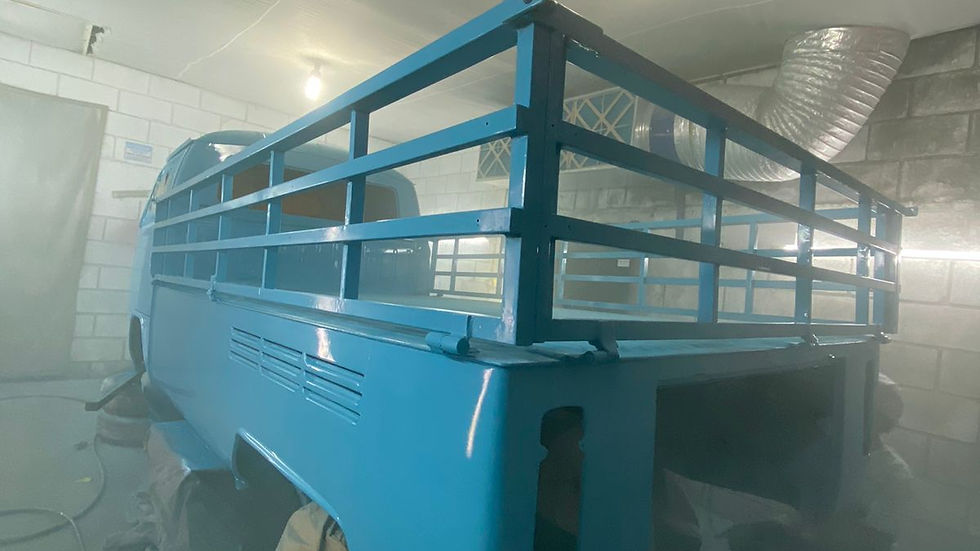The Art of Automotive Paint Restoration: A Comprehensive Guide
- Terry Weisenfeld
- Apr 19
- 4 min read
Updated: Jun 25

Automotive paint restoration appeals to both car enthusiasts and everyday drivers. Turning a dull exterior into a breathtaking masterpiece is incredibly rewarding. This transformation is especially gratifying after acquiring a barn find or a project car. In this blog post, we delve into the key aspects of paint restoration, effective preparation techniques, and practical advice on maintaining your vehicle's impressive appearance for years. Learn about reliable methods for achieving a finish that respects the origins and heritage of your beloved classic.

Understanding Automotive Paint
Automotive paint enhances a vehicle's appearance and protects it from rust, scratches, and environmental factors. Typically, a car's paint job consists of three layers: the base coat, color coat, and clear coat. Each layer plays a crucial role in ensuring durability and shine.
Different types of paint offer unique features. For instance, metallic paints contain tiny particles that reflect light, creating a sparkling effect. Conversely, pearlescent paints provide depth with their color-shifting properties. Understanding these differences is vital for restoration. If your car has a metallic finish that reflects 50% more light than standard paint, restoring its shine requires precise techniques to maintain that sparkle.
Restoring a vehicle's paint to its original condition—or achieving a finish superior to the original factory standard—has become more accessible for hobbyists and custom restoration garages. Thanks to advancements in materials, tools, and information sharing, modern hobby restorers can execute paintwork that competes with factory production lines. This is achievable if they adhere to updated techniques and protocols. Today's restoration practices emphasize careful preparation, smart use of new technologies, and environmentally friendly materials while focusing on craftsmanship.
Surface Preparation: The Key to Success
Thorough preparation is the cornerstone of successful paint restoration. For enthusiasts, careful prep work often distinguishes a show-quality finish from an amateur-looking result that fails to honor the car's heritage and history.
Stripping Old Paint
Hobbyists use various methods to remove old paint layers. These techniques include:
Chemical Strippers: Newer, environmentally friendly options have fewer harmful solvents and are safer for garage use.
Media Blasting: Soda or glass bead blasting is effective for paint removal.
DA (Dual-Action) Sanding: This method helps in leveling the surface efficiently.
Bodywork and Repairs
After stripping, restoring the metal surface is critical. Modern body fillers, such as lightweight polyester fillers and direct-to-metal (DTM) fillers, offer stronger adhesion and easier sanding compared to older materials. While "Bondo" can be effective in limited use, it may be structurally unsound if not applied correctly.
Rust Treatment
Epoxy primers have become the gold standard for hobbyists. After addressing any rust with converters or cut-and-replace metalwork, restorers apply epoxy primer for its excellent adhesion and corrosion protection.
Panel Alignment
With affordable measuring tools and straight edges available, many hobbyists now go the extra mile to align panels perfectly before painting—no more relying on "eyeballing" it.
Primer and Surface Application
Primers are no longer just a single spray-and-sand step. Today’s protocols emphasize layering and sealing.

Steps to Prime Effectively
Epoxy Primer: This layer bonds to bare metal and seals out moisture.
High-Build Primer Surfacer: Ideal for evening out the surface and filling in imperfections. It's designed for easy block sanding to create a flawless base.
The human eye can detect even the smallest details. Careful and thorough attention during this phase pays dividends in the long run.
Guide Coats
Hobbyists routinely use powder or aerosol guide coats during sanding to reveal low spots. This ensures perfectly smooth panels.
Guide Coat is a fine powder applied to a sanded surface, immediately revealing scratches and other imperfections to be addressed before finishing.
Modern Paint Options for Restorers
One significant shift in the last decade has been the availability of professional-grade paint systems for home use.
Types of Paint Systems
Basecoat/Clearcoat Systems: This two-step system remains the most popular for DIY projects.
Single-Stage Urethanes: Ideal for classic car restorations where authenticity is crucial. Single-stage urethanes combine color and gloss in one layer, replicating the traditional appearance with contemporary durability.
More Advanced Options
Custom and Candy Paints: Advances in pigment and pearl technologies allow hobbyists to achieve stunning custom finishes through proper planning.
Pre-Mixed Color Kits: Many paint suppliers now offer kits matched to OEM colors, taking much of the guesswork out of the process.
Application Techniques
The advent of affordable spray equipment has revolutionized home restoration.
Key Equipment
HVLP (High Volume Low Pressure) Spray Guns: Offer better transfer efficiency and improved control.
Mini-Jets and Touch-Up Guns: Ideal for small panels and intricate areas.
Portable Spray Booths: Inflatable booths create dust-free environments without the cost of a permanent structure. Removing invisible dust is essential.
Finishing and Polishing
Essential Tools for the Job
Using the right tools can significantly enhance your restoration efforts:
Polisher: An electric polisher speeds up the process and provides a consistent finish.
Cutting Compounds: Designed to eliminate paint imperfections, choose based on severity for optimal results.
Foam Pads: Various pads allow for tailored care depending on scratch severity.
Microfiber Cloths: Soft and non-abrasive, these are essential for wiping away residue.
Modern Finishing Practices
Finishing practices for hobbyists resemble those in professional detailing shops:
Color Sanding: Essential after clearcoat application for leveling the surface.
Compounding and Polishing: Dual-action polishers and modern compounds quickly remove sanding scratches and enhance the finish.
Ceramic Coatings: Some apply these coatings for lasting protection against UV rays and environmental damage, elevating their restoration efforts.
With these techniques and tools, amateur restorers can achieve professional-grade finishes.
Challenges and Tips for Success
Thanks to advancements in materials and techniques, automotive paint restoration is now more accessible. By following modern preparation methods and utilizing the latest paint technologies, today’s amateur restorers can achieve finishes rivaling those of professional workshops.
Restoration is not just about repainting. It is about revitalizing craftsmanship and preserving automotive history—one panel at a time.




Comments